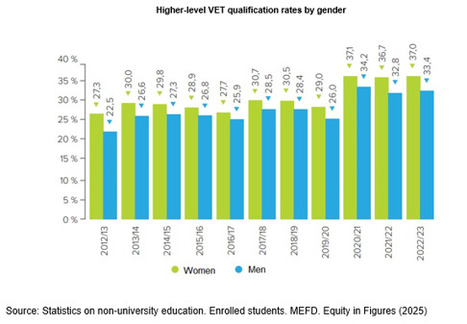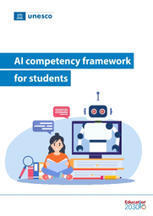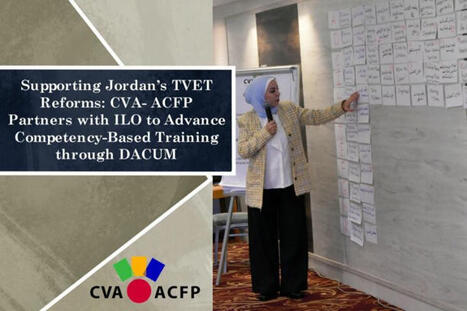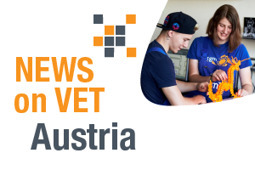 Your new post is loading...
 Your new post is loading...
Vancouver, July 2025 — The Canadian Vocational Association (CVA-ACFP) delivered a DACUM I training workshop in Vancouver, British Columbia, for a select group of professionals from WorkSafeBC. The five-day training, led by John Avery (President of CVA-ACFP and DACUM trainer) and Bruno Chauvel (CVA-ACFP DACUM trainer), marked a significant milestone in the advancement of competency-based methodologies within WorkSafeBC, British Columbia’s provincial agency responsible for promoting workplace health and safety, preventing injuries, and supporting return-to-work programmes for injured workers.
More women in Spain are enrolling in vocational education and training (VET), with recent data showing steady growth in participation and qualification rates across levels and professional branches.
The government's efforts to transform and modernise vocational training over the last six years have contributed to a new record in enrolment figure of 1 193 260 students in the 2024/25 academic year. Although females still participate more in upper secondary general education, more and more are engaging in VET programmes.
This report examines the progress made over two decades (2000-2020) in transforming lifelong learning into a reality for individuals in Europe. The study finds that, while significant progress has been made in promoting flexible and inclusive education and training systems, barriers and challenges remain.
Key changes include increased opportunities for personalisation of learning experiences, expansion of quality education and training pathways with improved accessibility, and easier portability of qualifications across countries. However, challenges persist.
These include fragmented strategies and limited coordination between sectors, implementation hurdles, underuse and underdevelopment of credit systems and quality assurance frameworks, low uptake of validation of non-formal and informal learning, and variations in the recognition of qualifications.
The report provides policy recommendations to address these challenges, including promoting a cohesive strategy with stronger cross-system stakeholder collaboration, integrating non-formal and informal learning, and strengthening the capacity of institutions and stakeholders to further support their implementation.
The report explores the causes and magnitude of anticipated skills shortages through at least 2032. It also examines potential strategies to address impending skills shortages and mitigate their economic impacts.
AI often feels abstract, as a cheat or intimidating, especially for educators deeply rooted in hands-on, practical teaching. However, it doesn't have to be. AI can become a powerful ally in your pedagogical toolkit with the right understanding and tools. In this blog, I will explore how AI is reshaping technical education, why TVET educators have nothing to fear from its rise, and how it can directly support the development of practical skills. Together, we'll uncover the unique opportunities the AI era offers to TVET professionals and learners alike.
It’s 2027. You wake up, ask your AI assistant for job leads, and it replies:
“Good morning! As you completed a micro-credential course in behavioural design and have five recommendations for your green tech skills, I’ve found three job leads that closely match your profile. Shall we prep your applications?”
You sigh – not from stress, but relief. Thanks to AI you can more easily showcase your unique skills – not only qualifications – which are the main way you promote yourself to employers.
Let’s rewind to present day.
This Working Paper addresses a critical gap in our understanding of how higher education can effectively prepare students, faculty, and staff for an AI-driven world.
Technical Vocational Education and Training (TVET) has long been the central pillar in producing highly skilled human capital in technical and vocational fields in Malaysia. In 2023, the TVET
matriculation curriculum was introduced in Malaysian education to meet the growing demand for TVET in the country. However, concerns persist regarding its effectiveness in preparing students for their career advancement. This paper summarizes the findings based on the survey instrument that was distributed to the first batch of students who took the TVET matriculation program. For the survey, 162 questionnaires were distributed. The analysis was conducted based on 149 valid questionnaires, with a response rate of 92%, obtained through a rigorous selection process. The results from the analysis show that career opportunities were the main factor in driving students to choose this program, with 49% of respondents emphasizing this factor. From an academic perspective, 75.2% of the students had a background in pure science during secondary school, indicating an interest and
inclination towards technical disciplines. Meanwhile, 40.9% of students stated interest as the main factor influencing their choice. These results show that TVET continues to be a relevant choice among students who want to build a strong career
Abstract
The AI and the Future of Skills (AIFS) project at the OECD’s Centre for Educational Research and Innovation (CERI) presents a framework to systematically measure artificial intelligence (AI) and robotic capabilities and compare them to human skills. This chapter gives an overview of AI performance across each of the OECD’s AI Capability Indicators. The first section introduces a comparative table and provides the information needed to understand it. The table indicates the current level of AI in each domain and describes the sorts of capabilities possessed by cutting-edge AI systems in November 2024. Below the table, a brief commentary explains the rationale for the OECD’s expert group rating of AI systems at that level and the capabilities that would allow AI systems to progress to the next level.
The UNESCO AI competency framework for students aims to help educators in this integration, outlining 12 competencies across four dimensions: Human-centred mindset, Ethics of AI, AI techniques and applications, and AI system design. These competencies span three progression levels: Understand, Apply, and Create. The framework details curricular goals and domain-specific pedagogical methodologies.
Generative AI could change — not just replace — jobs in Canada
Selections Supporting Jordan’s TVET Reforms: CVA-ACFP Partners with ILO to Advance Competency-Based Training through DACUM As part of a technical partnership with the International Labour Organization (ILO), the Canadian Vocational Association – Association canadienne de la formation professionnelle (CVA-ACFP) supported a key phase of Jordan’s vocational training reform by delivering two DACUM I training workshops in March 2025. These workshops were designed to strengthen the capacity of the Technical and Vocational Skills Development Commission (TVSDC) and align with Jordan’s National Human Resources Development Strategy (NHRDS), which emphasises competency-based learning, labour market relevance, and employability.
“This project exemplifies the role of DACUM as a globally recognized tool for workforce transformation,” said John Avery, President of CVA-ACFP. “It has been an honor to work with such dedicated professionals in Jordan as they move toward a more agile, responsive, and standards-based training system.”
Read the full article here ________________________________________________________________
The first ‘DACUM International’ vocational project: An unprecedented competency framework in French for peer support workers in eating disorders
Spring 2025 marks the culmination of an exceptional human and professional adventure: the completion of the competency framework for French-speaking peer support workers specializing in eating disorders (PA-TCA): the Référentiel de compétences pair-aidante TCA.
The framework has been delivered to the University Hospital Center of Nantes (France), which supported and accompanied this structuring initiative for the professionalization of peer support in eating disorders.
Over the past several months, a committed group of practitioners from Belgium, France, Québec, and Switzerland came together to co-construct this competency framework, with the support of Pierre Morin Formation Inc., and in full compliance with the CVA-ACFP quality charter.
Through online workshops, rich exchanges of experiences formalized general areas of competency, professional tasks, key actions, and transversal skills mobilised by peer support workers, who play a crucial role in the recovery journeys of people living with eating disorders.
Read the full article here
___________________________________________________________________
Bruno Chauvel's pick of the month, DACUM francophone trainer and CVA-ACFP Board Member
Canada. Canadians need better skills training and recognition to tackle 21st century challenges
Source: Policy Options
In this timely article, the authors call for a much-needed shift in Canada’s skills development and recognition systems. While Canada’s education system performs respectably in international assessments -notably, Canadians are strong performers in adaptive problem-solving- the article underscores a lack of flexible, employment-relevant learning pathways and credential recognition.
This analysis builds on the 2024 report prepared by the Conference Board of Canada for the Future Skills Centre, which highlights the urgent need to better align skills development with economic resilience and national productivity. The message is clear: Canada must do more to recognise the skills its people already have - and make them count across sectors and provinces.
At the Canadian Vocational Association (CVA), we believe this transformation must begin with competency-based approaches. Tools like DACUM enable the transparent identification of job-specific competencies and support the design of modular, adaptable training and certification pathways.
Canada must be able to strengthen the versatility, comparability, and portability of skill sets across provinces — not by enforcing uniform training routes, but through robust and well-articulated upskilling and reskilling strategies, underpinned by shared occupational mappings and clearly defined blocks of competencies to certify. These foundational elements are essential to enable recognition and mobility across diverse provincial systems, while still allowing contextual flexibility.
For educators, employers, and policy leaders alike, this article offers a timely reminder: how we recognise skills is just as vital as how we develop them.
_________________________________________________________________ The Newsletter Interested in receiving the CVA/ACFP free bi-monthly Newsletter? Our #DACUM training calendar 2025 For more information on DACUM or write to dacum@cva-acfp.org Join our online community - Scoop.It! @Canadian Vocational Association / Association canadienne de la formation professionnelle
In Mozambique, where violence and displacement have upended countless lives, a new initiative is harnessing the power of technical and vocational education and training (TVET) to foster peace and social cohesion. Cabo Delgado, Mozambique (ILO News) – As violence and displacement continue to disrupt lives in northern Mozambique, a new effort is taking shape to turn technical and vocational education and training (TVET) into catalysts for peace. Working in a fragile context, the International Labour Organization (ILO), in collaboration with the National Directorate for Local Economic Development (DNDEL) and with funding from Sida (Swedish cooperation) and the International Fund for Agricultural Development (IFAD), has launched a process to adapt its global guide "Promoting Social Cohesion and Peaceful Coexistence in Fragile Contexts through TVET" to the Mozambican reality. The project comes in response to the ongoing insurgency that has gripped Cabo Delgado since 2017, displacing over one million people, many of whom are now living in precarious conditions in neighbouring provinces like Nampula, Niassa, and safer districts within Cabo Delgado. Youth and women among the internally displaced populations (IDPs) are particularly vulnerable—facing not only limited access to livelihoods but also trauma, discrimination and social exclusion. The adaptation of the guide is rooted in the urgent need to respond to the consequences of displacement and social fragmentation in northern Mozambique. As IDPs settle in new communities, tensions can arise from competition over resources, cultural misunderstandings, and lack of integration mechanisms. Without targeted interventions, these tensions risk undermining social fabric and stability. Turning TVET into a tool for healing
|
The dual system in Austria depends on companies’ willing and ability to train apprentices. This is done on a voluntary basis and, so businesses must weigh the costs against the benefits. The latest analyses reveal that this investment pays off for many businesses, both economically and through various non-monetary benefits.
Since the 1970s, regular studies have assessed the costs and benefits of company-based training. At the end of 2024, a report on the professional image screening was published, providing a cost-benefit analysis of apprenticeship training.
This report offers an overview and analysis of WBL in Serbia, providing insights into various aspects of its design and implementation. The key messages highlight the importance of aligning the country’s WBL practices with the European quality criteria, emphasising the progress made in recent years, while identifying areas for further improvement. The findings cover WBL in initial vocational education and training (IVET), WBL in continuing vocational education and training (CVET), and WBL in active labour market programmes (ALMPs)
Ministers responsible for Vocational Education and Training (VET) from across Europe convened in Herning, Denmark, on 11 September to endorse “The Herning Declaration on attractive and inclusive Vocational Education and Training for increased competitiveness and quality jobs 2026-2030”. The forward-looking Declaration marks a pivotal moment for European skills policy as the continent leads digital and green transformations to meet economic competitiveness challenges
Artificial intelligence (AI) is reshaping the way we learn, teach and make sense of the world around us, but it is doing so unequally. While one-third of humanity remains offline, access to the most cutting-edge AI models is reserved for those with subscriptions, infrastructure and linguistic advantage. These disparities not only restrict who can use AI, but also determine whose knowledge, values and languages dominate the systems that increasingly influence education. This anthology explores the philosophical, ethical and pedagogical dilemmas posed by disruptive influence of AI in education. Bringing together insights from global thinkers, leaders and changemakers, the collection challenges assumptions, surfaces frictions, provokes contestation, and sparks audacious new visions for equitable human-machine co-creation. Covering themes from dismantling outdated assessment systems to cultivating an ethics of care, the 21 think pieces in this volume take a step towards building a global commons for dialogue and action, a shared space to think together, debate across differences, and reimagine inclusive education in the age of AI. Building on UNESCO’s Recommendation on the Ethics of AI, its Guidance on Generative AI in Education and Research and its twin AI competency frameworks for teachers and students, such a global commons can direct collective sense-making and bold reimagination around curricula, pedagogy, governance and policy with human rights, justice and inclusion at its core. Cutting-edge AI models empower some, while 1/3 of humanity remains offline
Teacher self-efficacy refers to teachers' beliefs in their capacity to influence student learning and engagement. A strong sense of self-efficacy has been identified as a key factor associated with instructional practices and the quality of teacher–student relationships. The present study focuses specifically on vocational education and training (VET) pathways, and aims to examine the impact of teachers' sense of self-efficacy on the academic performance of VET students. In addition, this study evaluates the suitability of the Teachers' Sense of Efficacy Scale (TSES) for use with VET teachers. Data from a survey of 285 vocational education and training teachers were analyzed. The findings indicate a redefined questionnaire structure, revealing a new item distribution. Moreover, the results show that teachers' sense of self-efficacy significantly predicts students' academic performance. However, when considering the newly identified factors, certain dimensions exhibit contrasting influences on students' academic performance. Thus, Efficacy in Promoting Engagement and Adaptation positively influences students' academic performance, while Efficacy in Questioning and Explaining is associated with a negative impact. This study sheds light on the relation between teacher self-efficacy, individual and contextual factors, and student academic performance in vocational education.
University World News publishes a special report this week, leading with exclusive interviews with the presidents of Gaza’s three main universities. We report on the response to their call for practical support from global higher education, while Ahmed Kamal Junina outlines how education has survived.
As the EU moves towards its 2030 skills targets and aims to boost long-term competitiveness, a critical shortage of qualified VET teachers is undermining efforts to equip young people with the skills needed for tomorrow's economy and society.
This joint Cedefop-ETF policy brief provides an overview of vocational education and training (VET) policy developments from 2021 to 2025 in the EU-27, Norway, Iceland and five candidate countries (Albania, Montenegro, North Macedonia, Serbia, and Türkiye).
It highlights countries’ activities to advance EU priorities in making national VET systems agile, flexible, excellent, attractive, inclusive and quality-assured, with selected examples illustrating progress across EU Member States and candidate countries.
Findings from Cedefop and ETF monitoring and analysis point to key areas requiring continued efforts in the coming years, aligned with new European priorities.
Coordinating and sustaining policy effort and resource allocation amid political change
Strengthening labour market involvement in VET and lifelong learning policies
Advancing digital and green transitions in VET
Boosting VET attractiveness and participation
Improving VET teacher and trainer competences
Expanding lifelong learning opportunities for all
The Artificial Intelligence revolution is transforming higher education at an unprecedented pace, offering innovative opportunities to personalize university learning experiences, support professors and researchers in their daily tasks, and optimize the management of educational institutions. Our new report, “Artificial Intelligence Revolution in Higher Education: What You Need to Know,” brings together the main advances driven by artificial intelligence (AI), a powerful tool that offers practical solutions: • For university students: Personalized tutoring systems, adaptive learning platforms, and immediate feedback tools tailored to the needs of each degree program and specialization. • For faculty and researchers: Academic planning assistants, automated assessment tools, and advanced research resources that enhance scientific production and teaching quality. • For higher education institutions: Early warning systems, resource optimization, and institutional management platforms that improve efficiency, student retention, and educational quality.
Migration is increasing due to political and economic instability, with the Arab States experiencing a substantial rise in refugees, migrants, and internally displaced persons. In response, this study, initiated by UNESCO-UNEVOC in collaboration with UNRWA, examines the barriers to accessing Technical and Vocational Education and Training (TVET) for migrants and refugees, while also exploring promising practices and interventions in the region that support their inclusion.
Based on an extensive literature review and interviews with key stakeholders, the study reveals that with adequate support, such as through UNESCO/UNEVOC’s capacity building pilot projects, TVET institutions can make meaningful progress in addressing inclusion challenges. However, the study emphasises the need for both state and international efforts to establish an enabling environment that supports inclusive practices. This includes removing key barriers, such as legal and financial obstacles, that hinder TVET institutions from effectively implementing inclusive practices and prevent learners from fully participating in and benefiting from TVET.
In vocational education (VE), as in other forms of education, teachers’ assessment competence is considered an integral part of their teaching competence and is, therefore, critical for the quality of assessment practices (Brookhart 2011; Popham 2009). This implies that competent teachers perform adequately within authentic assessment situations (Mulder 2014; Vitello et al. 2021). Assessment competence includes both practical skills and knowledge, as well as attitudes and perceptions that influence teachers’ behaviour (Xu and Brown 2016). It therefore includes teachers’ perceptions of what is important to know and be able to do to act competently in assessment practices. For example, when teachers perceive incorporating new assessment methods into their practice as highly important, they may actively engage in activities to update and adapt their assessment competence.
In literature, teachers’ assessment competence is approached as a contextual and social process (Pastore and Andrade 2019; Willis et al. 2013; Xu and Brown 2016). While definitions of assessment competence offer a foundational framework (Herppich et al. 2018; Pastore and Andrade 2019; Xu and Brown 2016), teachers give meaning to their assessment competence when enacted in their assessment practice. To illustrate, when teachers perceive the implementation of generative AI in assessment as highly important, they are likely to hold the opinion that assessment-competent teachers should be able to integrate generative AI into their assessment practice in responsible and informed ways. In this way, their perceptions, shaped by their professional context, inform how they understand assessment competence in practice.
While teachers’ perceptions of assessment competence are thus important, studies specifically addressing teachers’ perceptions are scarce. In addition, this research often relies on small sample sizes and primarily involves expert teachers within the field of assessment (Deneen and Brown 2016; Feola et al. 2023; Latif and Wasim 2022). Moreover, research on assessment competence typically focuses on the purposes and objectives of assessment in classroom situations (Brookhart 2011; Fulmer et al. 2019), without addressing the broader contexts beyond classroom situations. This broader context encompasses the wider educational context, including professional competence standards, educational policies, and learning outcomes of the study program as a whole (Chan and Luo 2021). VE teachers may be involved in designing study programs or in policy-making processes, positioning them as active contributors to assessment practices at the program or institutional level (Baartman et al. 2007; Lock et al. 2018; Stiggins and Duke 2008). Accordingly, VE teachers frequently engage in assessment-related roles that extend beyond the classroom (Kremmel and Harding 2020; Leonardsen et al. 2022). They may be involved in curriculum development, serve on examination boards, or develop assessment policies. This suggests that perceptions of what is important for assessment competent teachers are shaped by a broader context than just classroom situations.
In the context of VE, teachers assess whether students are ready to start in vocational practice. VE assessment practices are grounded in the specific vocational practice for which students are being educated, focusing on practical situations and real-life scenarios (Bruijn et al. 2017; Lahn & Nore, 2019). Consequently, the cultures of vocational fields and practices are reflected in these assessment practices. These cultures shape not only what is assessed and how, but also how teachers perceive the importance of assessment competence. However, it remains unknown whether teachers perceive the importance of assessment competence differently across various contexts, which this study operationalizes by different vocational fields, assessment roles, or situations.
This study aims to map VE teachers’ perceived importance of assessment competence. The study was conducted in the Netherlands among teachers of professional studies in Universities of Applied Sciences. A large-scale study was conducted to represent a broad population of teachers, including various vocational fields, roles, and situations, allowing for the exploration of differences across these contextual variables.
|



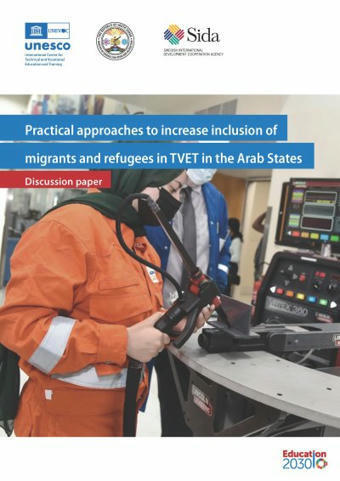


 Your new post is loading...
Your new post is loading...

